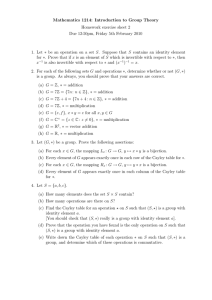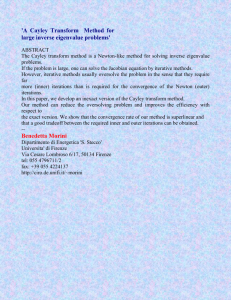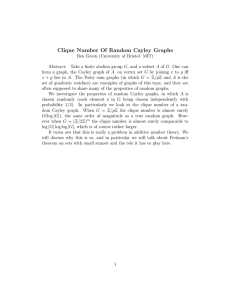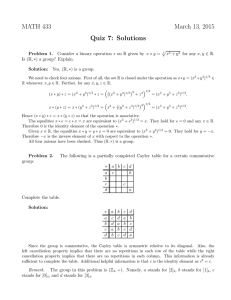Cayley transforms in micromagnetics P.S. Krishnaprasad*, Xiaobo Tan
advertisement
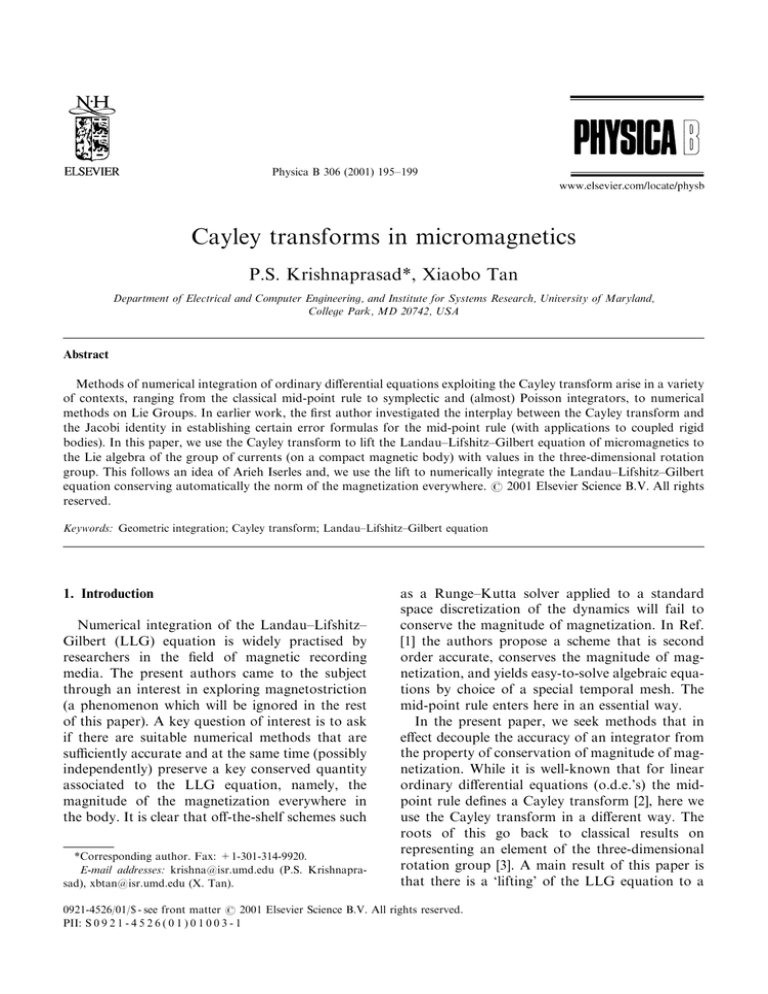
Physica B 306 (2001) 195–199 Cayley transforms in micromagnetics P.S. Krishnaprasad*, Xiaobo Tan Department of Electrical and Computer Engineering, and Institute for Systems Research, University of Maryland, College Park, MD 20742, USA Abstract Methods of numerical integration of ordinary differential equations exploiting the Cayley transform arise in a variety of contexts, ranging from the classical mid-point rule to symplectic and (almost) Poisson integrators, to numerical methods on Lie Groups. In earlier work, the first author investigated the interplay between the Cayley transform and the Jacobi identity in establishing certain error formulas for the mid-point rule (with applications to coupled rigid bodies). In this paper, we use the Cayley transform to lift the Landau–Lifshitz–Gilbert equation of micromagnetics to the Lie algebra of the group of currents (on a compact magnetic body) with values in the three-dimensional rotation group. This follows an idea of Arieh Iserles and, we use the lift to numerically integrate the Landau–Lifshitz–Gilbert equation conserving automatically the norm of the magnetization everywhere. r 2001 Elsevier Science B.V. All rights reserved. Keywords: Geometric integration; Cayley transform; Landau–Lifshitz–Gilbert equation 1. Introduction Numerical integration of the Landau–Lifshitz– Gilbert (LLG) equation is widely practised by researchers in the field of magnetic recording media. The present authors came to the subject through an interest in exploring magnetostriction (a phenomenon which will be ignored in the rest of this paper). A key question of interest is to ask if there are suitable numerical methods that are sufficiently accurate and at the same time (possibly independently) preserve a key conserved quantity associated to the LLG equation, namely, the magnitude of the magnetization everywhere in the body. It is clear that off-the-shelf schemes such *Corresponding author. Fax: +1-301-314-9920. E-mail addresses: krishna@isr.umd.edu (P.S. Krishnaprasad), xbtan@isr.umd.edu (X. Tan). as a Runge–Kutta solver applied to a standard space discretization of the dynamics will fail to conserve the magnitude of magnetization. In Ref. [1] the authors propose a scheme that is second order accurate, conserves the magnitude of magnetization, and yields easy-to-solve algebraic equations by choice of a special temporal mesh. The mid-point rule enters here in an essential way. In the present paper, we seek methods that in effect decouple the accuracy of an integrator from the property of conservation of magnitude of magnetization. While it is well-known that for linear ordinary differential equations (o.d.e.’s) the midpoint rule defines a Cayley transform [2], here we use the Cayley transform in a different way. The roots of this go back to classical results on representing an element of the three-dimensional rotation group [3]. A main result of this paper is that there is a ‘lifting’ of the LLG equation to a 0921-4526/01/$ - see front matter r 2001 Elsevier Science B.V. All rights reserved. PII: S 0 9 2 1 - 4 5 2 6 ( 0 1 ) 0 1 0 0 3 - 1 196 P.S. Krishnaprasad, X. Tan / Physica B 306 (2001) 195–199 space of fields with values in skew symmetric matrices. Required numerical methods follow from this. 2. Model The Landau–Lifshitz–Gilbert equation takes the form qM ga ¼ g0 M Heff þ 0 M ðM Heff Þ; ð1 þ a2 Þ qt Ms ð1Þ where M ¼ Mðt; xÞ denotes the time dependent magnetization at a point xAB; the ferromagnetic body (viewed as a compact subset of R3 ). The effective field Heff is the sum of the external field, the exchange field, the anisotropy field and the demagnetizing field. From the structure of Eq. (1), it follows that jjMðt; xÞjj2 ¼ Ms2 for all time t > 0; if it is true at t ¼ 0: Further in terms of the free energy functional E; one finds Heff ¼ dE=dM; negative of the variational derivative [4]. Throughout this paper we treat the external field as time independent. System (1) evolves on the space of maps from B to S 2 ; the two-dimensional sphere. Any spatial discretization of Eq. (1) yields a system of o.d.e.’s of the form ’ i ¼ aMi Hieff þ bMi ðMi Hieff Þ; M ð2Þ where i ¼ 1; 2; y; N denotes the site of magnetization, and a and b are constants, with b proportional to a; the damping factor. The o.d.e.’s (2) are coupled through the effective field. Letting Ed denote a discrete approximation to the free energy, one can write dEd ð3Þ Hieff ¼ i ; dM and rewrite system (2) in the form d d ’ i ¼ aMi dE þ bMi Mi dE M ; dMi dMi i ¼ 1; 2; y; N: ð4Þ The discrete dynamical system has interesting mathematical/physical structure that applies over all possible discrete free energy functions. If b ¼ 0; the system is a (reduced) hamiltonian system in the Lie–Poisson form [2,5] with conserved hamiltonian Ed : Even if ba0 (i.e. in the presence of the socalled double-bracket dissipation [6]) there are N conserved quantities jjMi jj; i ¼ 1; 2; y; N; the magnitudes of the magnetization at each site. This last remark follows by differentiating Mi Mi and invoking Eq. (4). Consider the standard isomorphism between vectors in R3 and 3 3 skew symmetric matrices, # : R3 -soð3Þ ¼ Lie algebra of 3 3 skew symmetric matrices 0 x1 1 0 0 B C B x ¼ @ x2 A/x# ¼ @ x3 x3 x2 x3 0 x1 x2 1 C x1 A: 0 ð5Þ # Observe the elementary identities x y ¼ xy # y y# x; # a matrix commutator (¼Lie and xd y ¼ x# # y# ). bracket ½x; It is now possible to write the discrete dynamics (2) and (4) in the form ’ i ¼ Fi ðMÞMi ; M i ¼ 1; 2; y; N; ð6Þ where, using Eq. (5), we have defined " # dd dd dE i dE i # ; b M F ðMÞ ¼ a dMi dMi h i i i #i b M # ;H # ¼ aH i ¼ 1; 2; y; N: eff eff ; In Eq. (6), M stands for the stacked vector of all magnetizations Mi at all sites. Thus M defines a point in the Cartesian product of spheres ðS 2 ÞN : See also Ref. [7]. System (6) is analogous to the dynamics of an assembly of linked rigid bodies (with strong material symmetries) [8]. In their work [7], Lewis and Nigam develop a lifting approach inspired by the method of moving frames due to Cartan (further elaborated by Olver and others). They are clearly aware of the work of the Cambridge–Norway school on integration on manifolds. But their work involves the use of free actions on tangent bundles on spheres and schemes involving acceleration updates. Here we are led to a rather simple approach to lifting suggested in the following section. 197 P.S. Krishnaprasad, X. Tan / Physica B 306 (2001) 195–199 3. Lifting construction Since each Mi ðtÞ evolves on a sphere S 2 ; given jjMi ð0Þjj ¼ Ms ; i ¼ 1; 2; y; N; there is a curve Ui ðtÞ evolving on SO(3), the Lie group of 3 3 rotation matrices such that Mi ðtÞ ¼ Ui ðtÞMi ð0Þ; ð7Þ and Ui ð0Þ ¼ I; the 3 3 identity matrix. The curves in each copy of SO(3) define a curve UðtÞ in the Cartesian product group ðSOð3ÞÞN : Each Ui ðtÞ satisfies the o.d.e. ’ i ðtÞ ¼ Fi ðUðtÞMð0ÞÞUi ðtÞ; U i ¼ 1; 2; y; N; ð8Þ where UðtÞ should be understood as a block diagonal matrix with Ui ðtÞ as its ith block. Solving Eq. (8) in SO(3), numerically, and substituting in Eq. (7) is tantamount to solving the discrete magnetization dynamics. It is unfortunately no easier than trying to conserve jjMi jj numerically. However the Cayley transform comes to our rescue. Given any element U of SO(3) not within the set of measure zero fPASOð3Þ: 1A spectrum ðPÞg; one can write U ¼ ðI 12XÞ1 ðI þ 12XÞ; ð9Þ where the unique XAsoð3Þ; the Lie algebra of 3 3 skew symmetric matrices. This classical representation [3] is useful in covering the manifold SO(3) by local coordinate charts and for a variety of practical purposes in kinematics of mechanisms, spacecraft attitude control, etc. The idea of lifting (suggested in the setting of numerical integration on Lie groups by Arieh Iserles of Cambridge University [9]) is very straightforward: derive a differential equation for Xi in Eq. (9) where Ui satisfies Eq. (8). First we define CayðXÞ to be the right hand side of Eq. (9). Then one can show ’ i ¼ Fi 1½Xi ; Fi 1Xi Fi Xi ; X 2 4 ð10Þ i ¼ 1; 2; y; N; where Fi ¼ Fi ðMðtÞÞ; ð11Þ Mi ðtÞ ¼ CayðXi ðtÞÞMi ð0Þ: ð12Þ Each of the o.d.e.’s in Eq. (10) evolves in a flat space of 3 3 skew symmetric matrices. We refer to (10)–(12) as the Cayley lift of the space discretized Landau–Lifshitz–Gilbert dynamics. Formally one can construct a lift of the Landau–Lifshitz–Gilbert partial differential equation too. Let Xðt; xÞ take value in so(3), the Lie algebra of the rotation group. Then the Cayley lift of the LLG equation is qX ¼ F 12½X; F 14XFX; qt ð13Þ where # eff b½M; # H # eff ; F ¼ Fðt; xÞ ¼ aH M ¼ Mðt; xÞ ¼ CayðXðt; xÞÞMð0; xÞ: System (13) evolves on the space of maps from B to so(3). This space is easily viewed (formally) as the infinite dimensional Lie algebra of the infinite dimensional Lie group of currents (¼ space of maps from B to SO(3)). See Ref. [10] for another perspective on the underlying geometry. Under the assumption of a compact body B; the relevant functional analytic details (which we omit here) can be worked out to make the formal construction rigorous. 4. Lifting and integration The discrete dynamics of the Cayley lift (10) can be integrated using methods of required accuracy. Unconditional stability will be achieved by suitable implicit schemes (with concomitant computational costs). The function evaluations (12) automatically conserve magnitude of magnetization to machine precision. We have effectively decoupled the conservation property from the question of accuracy. It should be pointed out that integrating Eq. (6) by the mid-point rule (for a regular temporal mesh of resolution h) yields, Mi ðk þ 1Þ Mi ðkÞ Mðk þ 1Þ þ MðkÞ ¼ Fi h 2 Mi ðk þ 1Þ þ Mi ðkÞ ; 2 ð14Þ 198 P.S. Krishnaprasad, X. Tan / Physica B 306 (2001) 195–199 Table 1 gives some comparative computational loads. In this, RK4 refers to the explicit fourth order Runge–Kutta scheme, Cay RK4 refers to the integration of (10) using RK4, and MP refers to the mid-point rule (14). Further studies based on the approach here are warranted to obtain additional speed-up and accuracy. Acknowledgements Fig. 1. Comparison of integration schemes on a 2 2 4 grid. Table 1 Computation time needed for calculation of the hysteresis loop (simulation done on Sun Ultra 10 workstation) Algorithm RK4 RK4 MP Cay_RK4 Stepsize (s) 13 2 10 6 1013 6 1013 6 1013 Time (s) 1656 953 789 367 or equivalently, the Cayley transform implicit scheme h i Mðk þ 1Þ þ MðkÞ 1 i M ðk þ 1Þ ¼ I F 2 2 h i Mðk þ 1Þ þ MðkÞ Iþ F Mi ðkÞ: 2 2 ð15Þ In this case accuracy is of order 2, and the scheme is implicit (with significant computational burden arising from the coupling in Heff ). We refer to similar considerations in the computational mechanics literature [11]. Numerical experiments with the Cayley lift of the spatially discretized LLG equation have been made together with comparisons with alternate schemes. The results are encouraging. Fig. 1 shows hysteresis computation on a small spatial grid. The work in this paper was supported in part by the Army Research Office under the ODDR&E MURI97 Program Grant No. DAAG55-97-10114 to the Center for Dynamics and Control of Smart Structures (through Harvard University). The numerical approach based on Cayley lift was first presented at the October 2000 annual review of the ARO MURI Center on Dynamics and Control of Smart Structures at Harvard University. At that time, the authors were not aware of the work of Lewis and Nigam [7]. One of us, (P.S.K.), became aware of it through a chance remark by Professor Weinan E during a discussion in Maryland, in May 2001. It is a pleasure to acknowledge further discussions on the subject with Professor Weinan E and Dr. Nilima Nigam at a Princeton Workshop on Micromagnetics in June 2001. References [1] C. Serpico, I.D. Mayergoyz, G. Bertotti, J. Appl. Phys. 89 (2001) 6991. [2] M.A. Austin, P.S. Krishnaprasad, L-S. Wang, J. Comput. Phys. 107 (1993) 105. [3] O. Bottema, B. Roth, Theoretical Kinematics, NorthHolland, Amsterdam, 1979. [4] A. Aharoni, Introduction to the Theory of Ferromagnetism, 2nd Edition, Oxford University Press, Oxford, 2000. [5] J.E. Marsden, T.S. Ratiu, Introduction to Mechanics and Symmetry: A Basic Exposition of Classical Mechanical Systems, 2nd Edition, Springer, New York, 1999. [6] A.M. Bloch, P.S. Krishnaprasad, J.E. Marsden, T.S. Ratiu, Commun. Math. Phys. 175 (1996). [7] D. Lewis, N. Nigam, A geometric integration algorithm with application to micromagnetics, Institute for Mathematics and its Applications Technical Report, University of Minnesota, September 2000. P.S. Krishnaprasad, X. Tan / Physica B 306 (2001) 195–199 [8] J.E. Marsden, P.S. Krishnaprasad, J.C. Simo (Eds.), in: Dynamics and Control of Multibody Systems, in Contemporary Mathematics Series, Vol. 97, American Mathematical Society, Providence, RI, 1989. 199 [9] A. Iserles, Numerical Analysis Group Report NA 1999-04, Cambridge University, 1999. [10] V.A. Aleksovskii, M. Lukatskii, Theoret. Math. Phys. 85 (1990) 1090. [11] D. Lewis, J.C. Simo, J. Nonlinear Sci. 4 (1994) 253.

